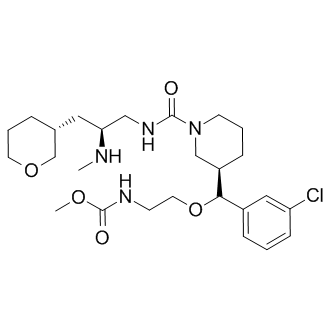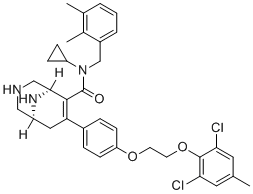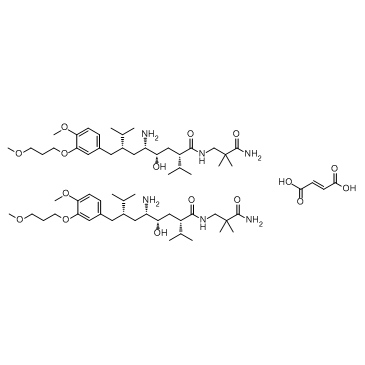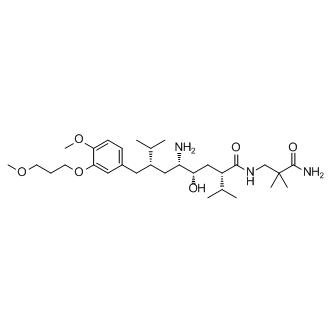Renin
Renin is a member of the family of aspartic proteases. These proteases have two highly conserved aspartic residues in the active cleft, which work optimally at acidic pH. In this aspect, renin is an exception, as it cleaves its substrate angiotensinogen at neutral pH in blood plasma. Renin is produced in juxtaglomerular (JG) cells as prorenin, which contains a 43-amino-acid prosegment that covers the active cleft. The prosegment inactivates the protease and thereby prevents intracellular proteolysis, but it is also thought to be important for folding, stability, and intracellular sorting of proteases. Renin generates angiotensin I by cleaving its unique substrate angiotensinogen. This first step is indispensable for the subsequent formation of angiotensin II. Thus renin is essential for sodium homeostasis and blood pressure regulation. The (Pro) renin receptor can also act as a signalling receptor for (pro)renin, independent from the formation of Ang I. Binding of (pro)renin to the (P)RR activates the mitogen-activated protein kinase (MAPK) extracellular signal-regulated kinase 1/2 (Erk1/2) in several cell types, including mesangial cells, collecting duct cells, VSMCs, monocytes, and neurons. Activation of Erk1/2 increases cell proliferation and stimulates production of transforming growth factor-β1 (TGF-β1), resulting in the upregulation of profibrotic factors, such as the plasminogen-activated inhibitor-1 (PAI-1), fibronectin, and collagen.
References
1.Manne Krop,et al. Pflugers Arch. 2013 Jan; 465(1): 87–97.
References
1.Manne Krop,et al. Pflugers Arch. 2013 Jan; 465(1): 87–97.
Metabolic Enzyme/Protease
11β-HSD(15)
15-PGDH(1)
ACC(10)
ACE(15)
AChE(47)
Adenylate Cyclase(12)
ALDH(14)
Aldose Reductase(5)
Aminopeptidase(19)
BACE(19)
Casein Kinase(51)
CAT(5)
Cathepsin(9)
CETP(13)
COMT(2)
CPG2(1)
CYPs(6)
Decarboxylase(3)
Dehydrogenase(131)
DGAT(4)
Dopamine beta-hydroxylase(2)
DPP(32)
Elastase(6)
FAAH(28)
Factor Xa(31)
Fatty Acid Synthase(17)
Ftase(2)
FXR(26)
Glucokinase(1)
GSNOR(2)
Guanylate Cyclase(13)
HMGCR(17)
IDH(7)
IDO(20)
IMPDH(2)
LDH(2)
LDL(8)
Lipase(17)
Lipid(12)
MAGL(6)
MAO(72)
MMP(78)
NAMPT(12)
Neprilysin(7)
Other Targets(10)
P450(112)
PAI-1(9)
Phosphatase(95)
Phospholipase(65)
PPAR(115)
Protein Phosphatase/PTP(6)
Renin(8)
Retinoid Receptor(37)
SCD(6)
Steroid Sulfatase (STS)(2)
Thioredoxin(1)
TPH(5)
Transferase(37)
Vitamin(44)
Xanthine Oxidase (XAO)(11)
Renin
-
Handle region peptide, rat
产品货号 : M30459
cas no: 749227-53-0
Handle region peptide, rat is a prorenin receptor antagonist, suppresses the progression of diabetic nephropathy and has anti-inflammatory in the eye.
-
VTP-27999
产品货号 : M16740
cas no: 942142-51-0
一种有效的、高选择性的肾素抑制剂,IC50 为 0.47 nM。
-
MK-8141
产品货号 : M16496
cas no: 903579-36-2
MK-8141 (ACT-077825) 是一种新型强效、选择性、直接肾素抑制剂,用于治疗心血管疾病。
-
Aliskiren hemifumarate
产品货号 : M12631
cas no: 173334-58-2
同类中第一种有效且高选择性的直接肾素抑制剂,IC50 为 0.6 nM。
-
Aliskiren
产品货号 : M12630
cas no: 173334-57-1
同类中第一种有效且高选择性的直接肾素抑制剂,IC50 为 0.6 nM。



 021-51111890
021-51111890 购物车(0)
购物车(0)
 sales@molnova.cn
sales@molnova.cn






